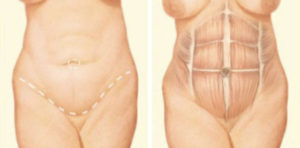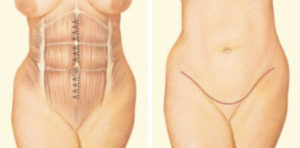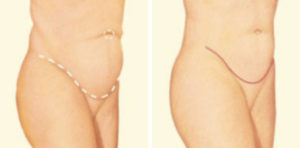What is Tummy tuck surgery or Abdominoplasty?
also known as abdominoplasty, removes excess fat and skin and, in most cases, restores weakened or separated muscles creating an abdominal profile that is smoother and firmer.
A flat and well-toned abdomen is something many of us strive for through exercise and weight control.
Sometimes these methods cannot achieve our goals. Even individuals of otherwise normal body weight and proportion can develop an abdomen that protrudes or is loose and sagging. The most common causes of this include:
- Heredity
- Pregnancy
- Prior surgery
- Significant fluctuations in weight
What tummy tuck surgery can’t do
A tummy tuck is not a substitute for weight loss or an appropriate exercise program.
Although the results of a tummy tuck are technically permanent, the positive outcome can be greatly diminished by significant fluctuations in your weight. For this reason, individuals who are planning substantial weight loss or women who may be considering future pregnancies would be advised to postpone a tummy tuck.
A tummy tuck cannot correct stretch marks, although these may be removed or somewhat improved if they are located on the areas of excess skin that will be excised.
Who is a good candidate for tummy tuck surgery?
A tummy tuck is a highly individualized procedure. You should do it for yourself, not to fulfill someone else’s desires or to try to fit any sort of ideal image.
In general, you may be a good tummy tuck candidate if:
- You are physically healthy and at a stable weight
- You have realistic expectations
- You are a nonsmoker
- You are bothered by the appearance of your abdomen
What should I expect during a consultation for tummy tuck surgery?
During your tummy tuck consultation be prepared to discuss:
Your surgical goals, Medical conditions, drug allergies and medical treatments, Current medications, vitamins, herbal supplements, alcohol, tobacco and drug use, Previous surgeries.
Your tummy tuck surgeon will also:
– Evaluate your general health status and any pre-existing health conditions or risk factors, ake photographs, Discuss your options, Recommend a course of treatment, Discuss likely outcomes of the tummy tuck and any risks or potential complication
– The success and safety of your tummy tuck procedure depends very much on your complete candidness during your consultation. You’ll be asked a number of questions about your health, desires and lifestyle.
It’s very important to understand all aspects of your tummy tuck procedure. It’s natural to feel some anxiety, whether it’s excitement for your anticipated new look or a bit of preoperative stress. Don’t be shy about discussing these feelings with your plastic surgeon.
What are the steps of a tummy tuck procedure?
A tummy tuck procedure includes the following steps:
Step 1 – Anesthesia
Medications are administered for your comfort during the surgical procedures. The choices include intravenous sedation and general anesthesia. Your doctor will recommend the best choice for you.
Step 2- Liposuccion of the anterior part of the abdomen if needed, specially the lateral part and the love handles, so we can get a very feminine and beautiful body curves.
Step 3 – The incision
A full tummy tuck requires a horizontally-oriented incision in the area between the pubic hairline and belly button. The shape and length of the incision will be determined by the amount of excess skin. Once the abdominal skin is lifted, the underlying weakened abdominal muscles are repaired.


The upper abdominal skin is pulled down like a window shade. The excess skin is trimmed and the remaining skin is sutured together. A new opening for the belly button is created. The belly button is popped through to the surface and sutured into position.

What should I expect during my tummy tuck recovery?
During your tummy tuck recovery, dressings or bandages may be applied to your incisions, and you may be wrapped in an elastic bandage or a compression garment to minimize swelling and support your abdomen as it heals following surgery.
Small, thin tubes may be temporarily placed under the skin to drain any excess blood or fluid that may collect.
The dressing will be removed one day after the operation. A compression garment should be worn to reduce the onset of edema. As for bruises related to the operation, they will persist for 2 to 3 weeks. Likewise, swelling may appear.
Sport and intense physical activities are prohibited before 1 month. Heavy loads should also be avoided during this period. In the long term, exercise is necessary to strengthen the abdominal strap and to maintain an ideal weight.
The results of the abdominoplasty
The overall result of the abdominoplasty is seen from the first days, especially if the loss of volume is noticeable. For a more refined overview, it will be necessary to wait for the third month and the disappearance of all the edemas. The final results are visible one year after the operation, when the scars reach their final appearance.
The duration of an abdominoplasty
Depending on the actions to be performed, an abdominoplasty lasts between 1 and 3 hours. In total, hospitalization lasts 1 to 2 days. Checks are carried out regularly for up to a year after the operation to ensure that the abdominal belt has recovered properly.
What are the risks of tummy tuck surgery?
The decision to have plastic surgery is extremely personal, and you’ll have to decide if the benefits will achieve your goals and if the risks and potential complications of tummy tuck surgery are acceptable.
You will be asked to sign consent forms to ensure that you fully understand the procedure and any risks.
Tummy tuck risks include:
- Anesthesia risks
- Asymmetry
- Bleeding
- Deep vein thrombosis, cardiac and pulmonary complications
- Fatty tissue found deep in the skin might die (fat necrosis)
- Fluid accumulation (seroma)
- Infection
- Numbness or other changes in skin sensation
- Persistent pain
- Poor wound healing
- Possibility of revisional surgery
- Recurrent looseness of skin
- Skin discoloration and/or prolonged swelling
- Skin loss
- Suboptimal aesthetic result
- Unfavorable scarring
These risks and others will be fully discussed prior to your consent. It’s important that you address all your questions directly with your plastic surgeon.
